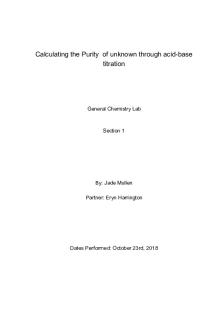Lab Report 9 Isolation and purification of Acetylsalicylic Acid PDF

| Title | Lab Report 9 Isolation and purification of Acetylsalicylic Acid |
|---|---|
| Course | Chemistry |
| Institution | High School - USA |
| Pages | 3 |
| File Size | 74.8 KB |
| File Type | |
| Total Downloads | 19 |
| Total Views | 132 |
Summary
Lab report on the Isolation and purification of Acetylsalicylic Acid...
Description
Experiment 9: Isolation and purification of Acetylsalicylic Acid Date of experiment: 11/19/19 Submission date: 12/3/19 Section: 010 TA: Rezoanul Islam Name:
Introduction: In this experiment a purification of Acetylsalicylic acid, or aspirin, was performed. In order to do this a technique called mixed solvent recrystallization was used where
two solvents are used instead of one. This technique was used because aspirin does not have a single good solvent that doesn’t cause part of it to be lost in filtration. Another technique used was hot filtration by using a filtration pipette because cold filtration would lose some of the product. Suction filtration using a vacuum filtration system that allowed the recrystallized sample to be cooled as well as to let any solvent still contained within the sample to evaporate.
Experiment: Data:
Weight of aspirin tablets (g)
0.743
Weight of watch glass (g)
39.792
Weight of aspirin after purification (g)
0.482
Theoretical mass: m(acetylsalicylic acid) = 325mg x2 =.325g x2 =0.65 Percent yield: 0.482/0.65 x 100= 74% Mel temp: 84℃
Conclusion: The results of this experiment found that a 74% percent yield was obtained. This lower yield could have been a result of errors in the lab such as not scraping the entirety of the sample into the funnel of the vacuum filtration flask from the erlenmeyer flask or some sample was lost when transferring the crystals to the watch glass from the funnel of the vacuum filtration flask. The melting point taken was found to be 84 ℃ while
the Handbook of Chemistry and Physics says the melting point of acetylsalicylic acid is 135 ℃. The lower melting point being obtained in the lab could be due to the sample not being completely dry as water would lower the melting point as would any impurities that happened to remain in the collected product. Also our sandbath could have been too hot, causing the crystals to melt earlier than intended.
References: 1. Department of Chemistry CHEM 2071 Organic Chemistry 1 Laboratory Manual, 2019 Edition; Macmillan learning Curriculum Solutions: Plymouth, MI; pp 59-60 2. Experiments with Aspirin. (n.d.). Retrieved from https://pubs.acs.org/doi/10.1021/ed077p354...
Similar Free PDFs

DNA Isolation Lab Report
- 4 Pages

Acid Ionization Lab Report
- 8 Pages

Lab Report 9 - lab
- 6 Pages

Acid base titration lab report
- 5 Pages
Popular Institutions
- Tinajero National High School - Annex
- Politeknik Caltex Riau
- Yokohama City University
- SGT University
- University of Al-Qadisiyah
- Divine Word College of Vigan
- Techniek College Rotterdam
- Universidade de Santiago
- Universiti Teknologi MARA Cawangan Johor Kampus Pasir Gudang
- Poltekkes Kemenkes Yogyakarta
- Baguio City National High School
- Colegio san marcos
- preparatoria uno
- Centro de Bachillerato Tecnológico Industrial y de Servicios No. 107
- Dalian Maritime University
- Quang Trung Secondary School
- Colegio Tecnológico en Informática
- Corporación Regional de Educación Superior
- Grupo CEDVA
- Dar Al Uloom University
- Centro de Estudios Preuniversitarios de la Universidad Nacional de Ingeniería
- 上智大学
- Aakash International School, Nuna Majara
- San Felipe Neri Catholic School
- Kang Chiao International School - New Taipei City
- Misamis Occidental National High School
- Institución Educativa Escuela Normal Juan Ladrilleros
- Kolehiyo ng Pantukan
- Batanes State College
- Instituto Continental
- Sekolah Menengah Kejuruan Kesehatan Kaltara (Tarakan)
- Colegio de La Inmaculada Concepcion - Cebu











